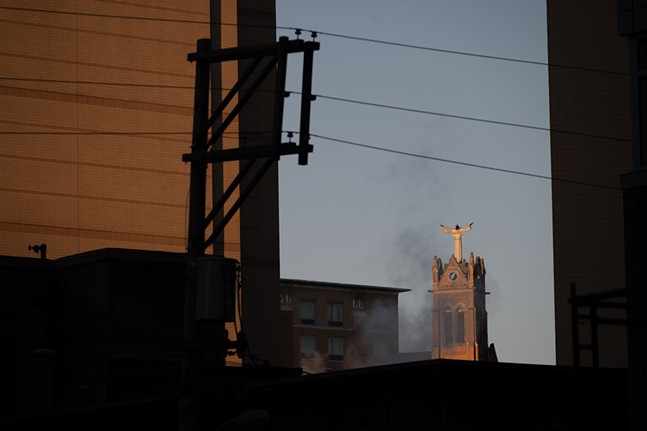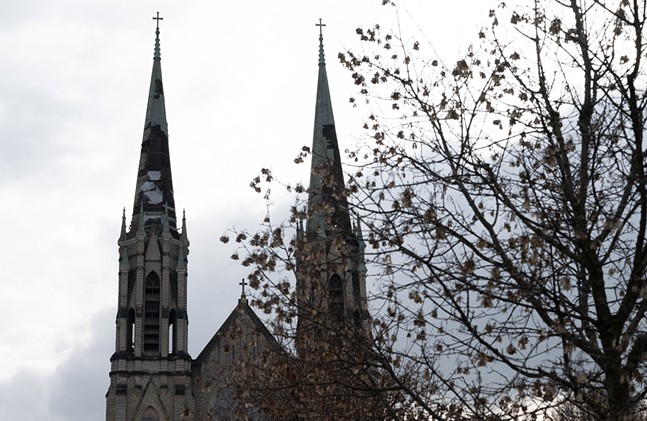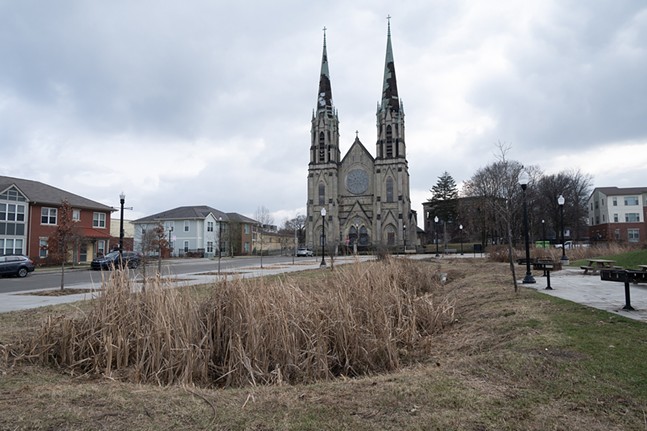
Pittsburgh has long been a bastion of Catholicism. The metro area ranks among the top cities for those belonging to the Catholic Church, and Pittsburgh elected its first Catholic mayor, David L. Lawrence, some 14 years before John F. Kennedy won the presidency.
Yet shifting demographics, a drop in church and parochial-school attendance, and fallout from the church's sex-abuse scandals in recent decades have lessened the Church's prominence in local life. Some of the city's most spectacular churches have sat vacant for years or been demolished due to unsafe conditions or redevelopment plans. In the past few years, a wave of parish consolidations seemed to further diminish the Diocese of Pittsburgh, giving local Catholics a sense of a church in retreat.
Ecclesiastical leaders say reports of the Church's death have been greatly exaggerated. They say parish consolidation and the closure or relocation of religiously affiliated schools are necessary and carefully planned measures to shore up the diocese, and they point to immigrant enthusiasm, youth curiosity, and an evolving understanding of faith as signs that Catholicism is as critical a part of the local landscape as ever.
In fact, if Church leadership is to be believed, Catholicism in Pittsburgh has its best days ahead of it.
The flood recedes
Zubik, a grandson of Eastern European immigrants, remembers when the "river towns" teemed with newcomers, many of them devout Catholics. He says the landscape has, since the diocese was founded in 1843, consistently reflected a wide variety of Catholic belief systems, with different nationalities and monastic orders each offering their own unique charisms, or ways of expressing the gospel through differing ecclesiastical traditions. Zubik points to the presence of Capuchins in Lawrenceville and Benedictines in the North Hills as examples of this intra-Church diversity.
"Our diocese is very rich when it comes to an appreciation of faith," Zubik says.
The Diocese of Pittsburgh was one of the first the Vatican founded in the U.S. during a time when Catholics were viewed with intense suspicion. At one point, anti-Catholic sentiment devolved into rioting in cities including Philadelphia. Still, the steel industry drew many thousands of devout immigrants to the region, and by the early 20th century, most neighborhoods in the city boasted at least one bustling Catholic church. In some, locals erected grand houses of worship to represent their varied cultures and charisms and show off their increasing wealth.
At its height in the mid-20th century, the Diocese of Pittsburgh consisted of 188 parishes plus additional churches across western Pennsylvania, with around 40 parishes in the City of Pittsburgh alone. Many operated busy schools that served an exploding population in the years following World War II.
The 1960s marked a time of great change in the city and the Catholic Church. A major part of this was Vatican II, a still-controversial ecumenical council convened by Pope John XXIII that paved the way for the end of Latin mass but doubled down on increasingly unpopular stances on topics including contraception. Following white flight to the suburbs, many urban churches fell into decline. Several were demolished as early as the 1960s owing to urban renewal, and many more had closed by the early 1990s.
And then came a long and painful reckoning with decades of sexual abuse.
A crisis of faith
The global nature of the Church's abuse crisis has been well-documented, though the full scope may never be clear. The Church has paid out billions to settle many thousands of claims, and locally, allegations of a coverup permanently damaged the reputation of Pittsburgh native Cardinal Donald Wuerl and likewise put Zubik in the hot seat."Any, even if it was just one person, that was hurt by abuse, was tragic in and of itself," Zubik says. He calls the scandal "a clarion call that we should take a look at policies and procedures to provide for safe environments." Though the Bishop has defended changes in Church policy and pointed to broader societal problems as part of the equation, Zubik says the Church accepts responsibility and has worked to "be there" for victims.
"I think that, while the church has done a great deal, we could never do enough," he adds.
Existing declines in church attendance got steeper following a wave of coverage that exposed systemic abuse within the Catholic Church.
One report found that the number of Pittsburgh locals identifying as Catholic had dropped by over 120,000 to a total around 632,000 between 2000 and 2016, while marriages, baptisms, confirmations, and the number of schools had fallen by nearly half during that time. Likewise, the number of diocesan priests was projected to fall from 338 in 2000 to just 112 by 2025. Following what Zubik describes as “an entire year in prayer and study,” the Church began a gradual drawdown of parishes in 2018, reducing the total number from 188 to 60 at the beginning of 2024.
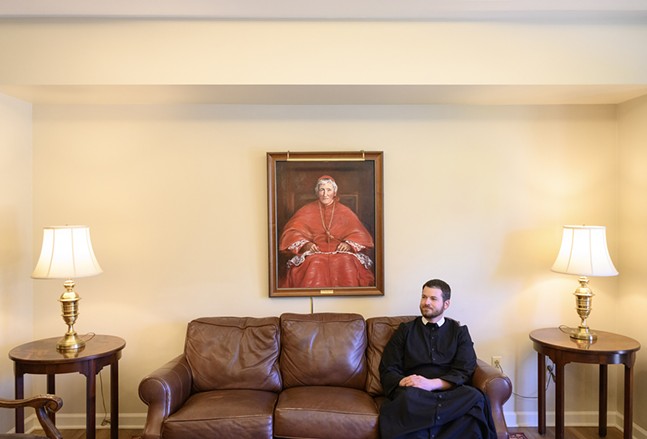
Father Peter Gruber, who grew up in Whitehall and now directs campus ministry at the Pittsburgh Oratory & Catholic Newman Center in North Oakland, says the sex-abuse crisis likewise forced him and other members of his "large Catholic family" to ask themselves — and the Church — tough questions. Gruber was ordained in 2017 and says the fallout remains a fact of life for men of the cloth in 2024.
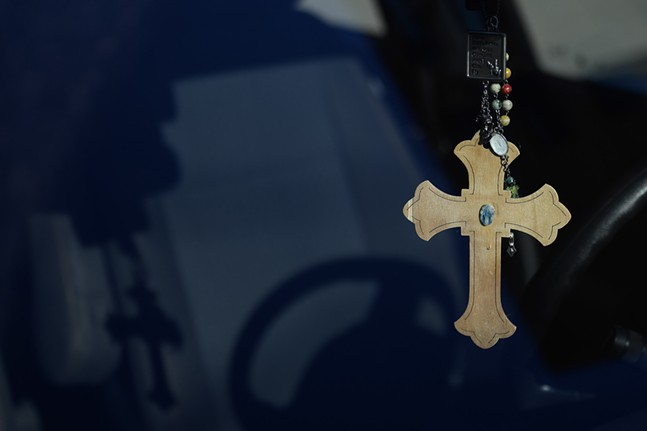
"That was a challenging experience and still is a challenging experience," Gruber tells City Paper. "The amount of evil done by priests made [it so that] when I'm dressed as a priest, which is often, I have to be conscious of how others will receive that." (As one example, Gruber says he's been publicly called a "pedophile.")
Gruber sees the situation as a reminder to be "an instrument of healing" and says it's also a sign of how the Church has been forced to reckon with its changing role in both local and global society — Gruber says he agrees with Pope Francis' assessment that "we can no longer take being Christian for granted" and must move from a "Christendom mindset" to an "apostolic mindset."
"We can no longer act in the same way that we have for the past 1,500 years," Gruber says. "We have to directly engage [the community] and primarily through relationships, through friendships, through heart-to-heart, one-on-one encounters."
Gruber has taken a "contra-modern" approach to his vocation, occasionally setting up chairs on Pitt's and CMU's campuses with a sign that says "Catholic priest available." Through lots of conversations and a few sunburns, Gruber says the exercise has helped him be closer to both Christ and the laity.
The "conversation doesn't have to be the most intellectually stimulating or theologically astute conversation. But just to meet people where they're at and be a bridge to Christ, that goes a long way," he says.
Tender shoots
He also says he's seen rising curiosity about the Church and growing interest among young men in seeking a priestly vocation because of, not in spite of, its challenges. In addition, he says, the chaos of the past few years has made this "a kind of fulcrum moment" for young Catholics and those curious about deepening their faith.
"We're going to see explosive growth that will be far beyond what anyone could have anticipated, especially seeing how bleak things are now," Gruber predicts.
While it may look like a sign of decline, consolidating parishes and switching to a regional school model has allowed the Church to better meet parishioners' needs — "That's the primary motivating factor for everything that we have done in terms of our parish life," Zubik says.
Michelle Peduto, outgoing superintendent of schools at the diocese, tells CP the diocese has worked hard to keep parochial schools "accessible, affordable, and sustainable for our families." She says Catholic schools have benefitted from Educational Improvement Tax Credit funding despite not having the same level of access to public money as charter schools. Zubik points out that enrollment at North Catholic High School has spiked from a low of 200 when the institution was in Troy Hill to almost 700 students todayin its newer suburban location.
Like Gruber, Zubik and the Diocese are working toward a greater emphasis on evangelization, which the Bishop has termed "firing up the faith." Diocesan executive director of communications Jennifer Antkowiak says this consists of "hosting gatherings here at the pastoral center, for example, and inviting lay ecclesial ministers to come and to worship together."
The Diocese hopes the fired-up faithful will reinvigorate parishes where numbers have slumped. Antkowiak and Zubik also say international arrivals to Pittsburgh, including a burgeoning Hispanic population in the South Hills, have brought their faith with them. These populations are keen to get involved with an upcoming National Eucharistic Pilgrimage running from Connecticut to Indianapolis via Pittsburgh.
"The Latino community, the Vietnamese, the Korean community, have definitely reached out to say we want to be part of this. And so we're looking forward to this all coming together in a really physical way," Antkowiak says.
Zubik sees the diocese, now in its 181st year, moving forward. The Bishop says the decades of consolidation were necessary, but he doesn't foresee another round in the future.
"We've done an awful lot of hard work to prepare for some of the challenges that we're faced with now," he tells CP. "We'[re] in a good spot for helping the Church of Pittsburgh to grow."
